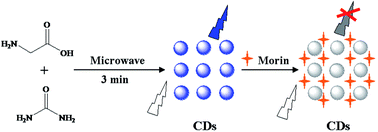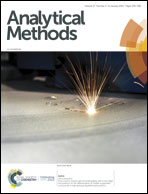Green synthesis of fluorescent carbon dots as an effective fluorescence probe for morin detection†
Abstract
In this article, a green, simple and economic method based on microwave treatment of glycine and urea was developed to synthesize water-soluble carbon dots (CDs) with strong fluorescence. The obtained CDs were characterized by transmission electron microscopy (TEM), UV-vis absorption spectroscopy, fluorescence spectroscopy, Fourier transform infrared spectroscopy (FTIR) and X-ray photoelectron spectroscopy (XPS). The results indicate that the as-synthesized CDs have an average diameter of 3.2 nm and exhibit excitation-dependent emission behavior. The surface of the CDs is rich in amine, amide, hydroxyl and carboxyl groups, which endow the CDs with strong fluorescence and good water solubility. We found that the as-synthesized CDs can be used as an effective fluorescence probe for morin detection based on the fluorescence quenching of CDs. The linear range for morin detection is 0.4–60 μM with a limit of detection (LOD) of 0.12 μM. The CD-based fluorescence sensor shows good selectivity and sensitivity toward morin sensing. Finally, the proposed sensing method was successfully applied to detect morin in human urine samples with recoveries of 97.7–104%.



 Please wait while we load your content...
Please wait while we load your content...